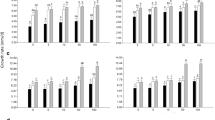Abstract
Growth and aflatoxin production by Aspergillus parasiticus NRRL 2999 and Aspergillus parasiticus RC 12 were studied both in sunflower seed and a synthetic culture medium (with and without zinc enrichment).
On a synthetic culture medium the strains behaved in different ways according to the zinc concentration.
In sunflower seed medium the influence of zinc was not so evident. Thus the results show that the influence of zinc is not the same for different strains and substrates.
Similar content being viewed by others
References
Davis ND, Diener VL: Environmental factors affecting the production of aflatoxins. In: Herzberg M (ed) Proceedings of the first U.S.-Japan conference on toxic micro-organisms. US Dept of the Interior, Washington DC, 1970, pp 43–47.
Detroy RW, Lillehoj E, Ciegler A: Aflatoxins and related compounds. In: Ajl EJ, Ciegler A, Kadis S, Montie TC, Weibaum G (eds) Microbial toxins: A comprehensive treatise, Vol 6, Fungal Toxins. Academic Press, New York, 1971, pp 3–178.
Diener UL, Davis ND: Aflatoxin formation by Aspergillus flavus. In: Goldblatt LA (ed) Aflatoxin. Academic press, New York, 1969, pp 13–54.
Failla LJ, Lynn D, Niehaus WG: Correlation of Zn2+ content with aflatoxin content of corn. Appl Environ Microbiol 52:73–74, 1986.
Gupta SK, Maggon KK, Venkitasubramanian TA: Effect of zinc on tricarboxylic acid cycle intermediates and enzymes in relation to aflatoxin biosynthesis. J of Gen Microbiology 99:43–48, 1977.
Hesseltine CW, Sorenson WG, Smith M: Aflatoxin formation by Aspergillus flavus. Bacteriol Rev 30:795–805, 1966.
Horowitz W: Methods of analysis of the Association of Official Analytical Chemists. 12th Edition. Association of Official Analytical Chemists, Washington, DC, 1975, pp 460–461.
Jones FT, Hagler WM, Hamilton PB: Correlation of aflatoxin contamination with zinc content of chicken feed. Applied and Environmental Microbiology 47:478–480, 1984.
Lee EG, Townsley PM, Walden CC: Effect of bivalent metals on the production of aflatoxin in submerged cultures. J Food Sci 31:432–436, 1966.
Nabney J, Nesbitt BF: Spectrophotometric method for determination of the aflatoxin. Analyst 90:155–160, 1965.
Niehaus WG, Failla LJ: Effect of zinc on versicolorin production by a mutant strain of Aspergillus parasiticus. Experimental Mycology 8:80–84, 1984.
Obidoa O, Ndubuisi El: The role of zinc in the aflatoxicogenic potential of Aspergillus flavus NRRL 3251 on foodstuffs. Mycopathologia 74:3–6, 1981.
Stossel P: Aflatoxin contamination in soybeans: Role of proteinase inhibitors, zinc availability and seed coat integrity. Applied and Environmental Microbiology 52:68–72, 1986.
Tyagi JS, Venkitasubramamian TA: The role of glycolysis in aflatoxin biosynthesis. Can J Microbiol 27:1276–1281, 1981.
Author information
Authors and Affiliations
Rights and permissions
About this article
Cite this article
Chulze, S., Fusero, S., Dalcero, A. et al. Aflatoxins in sunflower seeds: Effect of zinc in aflatoxin production by two strains of Aspergillus parasiticus . Mycopathologia 99, 91–94 (1987). https://doi.org/10.1007/BF00436911
Accepted:
Issue Date:
DOI: https://doi.org/10.1007/BF00436911




